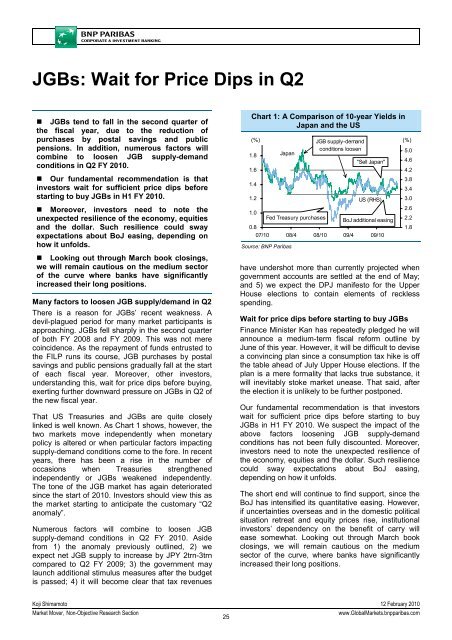Market Mover - BNP PARIBAS - Investment Services India
Market Mover - BNP PARIBAS - Investment Services India
Market Mover - BNP PARIBAS - Investment Services India
You also want an ePaper? Increase the reach of your titles
YUMPU automatically turns print PDFs into web optimized ePapers that Google loves.
JGBs: Wait for Price Dips in Q2<br />
• JGBs tend to fall in the second quarter of<br />
the fiscal year, due to the reduction of<br />
purchases by postal savings and public<br />
pensions. In addition, numerous factors will<br />
combine to loosen JGB supply-demand<br />
conditions in Q2 FY 2010.<br />
• Our fundamental recommendation is that<br />
investors wait for sufficient price dips before<br />
starting to buy JGBs in H1 FY 2010.<br />
• Moreover, investors need to note the<br />
unexpected resilience of the economy, equities<br />
and the dollar. Such resilience could sway<br />
expectations about BoJ easing, depending on<br />
how it unfolds.<br />
• Looking out through March book closings,<br />
we will remain cautious on the medium sector<br />
of the curve where banks have significantly<br />
increased their long positions.<br />
Many factors to loosen JGB supply/demand in Q2<br />
There is a reason for JGBs’ recent weakness. A<br />
devil-plagued period for many market participants is<br />
approaching. JGBs fell sharply in the second quarter<br />
of both FY 2008 and FY 2009. This was not mere<br />
coincidence. As the repayment of funds entrusted to<br />
the FILP runs its course, JGB purchases by postal<br />
savings and public pensions gradually fall at the start<br />
of each fiscal year. Moreover, other investors,<br />
understanding this, wait for price dips before buying,<br />
exerting further downward pressure on JGBs in Q2 of<br />
the new fiscal year.<br />
That US Treasuries and JGBs are quite closely<br />
linked is well known. As Chart 1 shows, however, the<br />
two markets move independently when monetary<br />
policy is altered or when particular factors impacting<br />
supply-demand conditions come to the fore. In recent<br />
years, there has been a rise in the number of<br />
occasions when Treasuries strengthened<br />
independently or JGBs weakened independently.<br />
The tone of the JGB market has again deteriorated<br />
since the start of 2010. Investors should view this as<br />
the market starting to anticipate the customary “Q2<br />
anomaly”.<br />
Numerous factors will combine to loosen JGB<br />
supply-demand conditions in Q2 FY 2010. Aside<br />
from 1) the anomaly previously outlined, 2) we<br />
expect net JGB supply to increase by JPY 2trn-3trn<br />
compared to Q2 FY 2009; 3) the government may<br />
launch additional stimulus measures after the budget<br />
is passed; 4) it will become clear that tax revenues<br />
Chart 1: A Comparison of 10-year Yields in<br />
Japan and the US<br />
2.0 (%) JGB supply-demand<br />
(%) 5.4<br />
1.8 Japan<br />
conditions loosen<br />
5.0<br />
"Sell Japan" 4.6<br />
1.6<br />
4.2<br />
1.4<br />
1.2<br />
1.0<br />
Fed Treasury purchases<br />
BoJ additional easing<br />
0.8<br />
07/10 08/4 08/10 09/4 09/10<br />
Source: <strong>BNP</strong> Paribas<br />
US (RHS)<br />
have undershot more than currently projected when<br />
government accounts are settled at the end of May;<br />
and 5) we expect the DPJ manifesto for the Upper<br />
House elections to contain elements of reckless<br />
spending.<br />
Wait for price dips before starting to buy JGBs<br />
Finance Minister Kan has repeatedly pledged he will<br />
announce a medium-term fiscal reform outline by<br />
June of this year. However, it will be difficult to devise<br />
a convincing plan since a consumption tax hike is off<br />
the table ahead of July Upper House elections. If the<br />
plan is a mere formality that lacks true substance, it<br />
will inevitably stoke market unease. That said, after<br />
the election it is unlikely to be further postponed.<br />
Our fundamental recommendation is that investors<br />
wait for sufficient price dips before starting to buy<br />
JGBs in H1 FY 2010. We suspect the impact of the<br />
above factors loosening JGB supply-demand<br />
conditions has not been fully discounted. Moreover,<br />
investors need to note the unexpected resilience of<br />
the economy, equities and the dollar. Such resilience<br />
could sway expectations about BoJ easing,<br />
depending on how it unfolds.<br />
The short end will continue to find support, since the<br />
BoJ has intensified its quantitative easing. However,<br />
if uncertainties overseas and in the domestic political<br />
situation retreat and equity prices rise, institutional<br />
investors’ dependency on the benefit of carry will<br />
ease somewhat. Looking out through March book<br />
closings, we will remain cautious on the medium<br />
sector of the curve, where banks have significantly<br />
increased their long positions.<br />
3.8<br />
3.4<br />
3.0<br />
2.6<br />
2.2<br />
1.8<br />
Koji Shimamoto 12 February 2010<br />
<strong>Market</strong> <strong>Mover</strong>, Non-Objective Research Section<br />
25<br />
www.Global<strong>Market</strong>s.bnpparibas.com
















